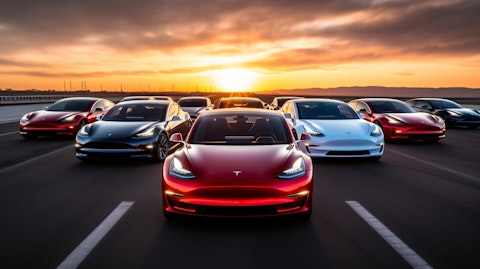We recently compiled a list of the 10 Best Battery Stocks To Buy Now According to Short Sellers. In this article, we are going to take a look at where Tesla, Inc. (NASDAQ:TSLA) stands against the other battery stocks.
Electric vehicles are the latest trend in the automotive market which is revolutionizing the whole industry. According to Grand View Research, the global electric vehicle (EV) market was valued at $1.07 trillion in 2023 and is projected to grow at a compound annual growth rate (CAGR) of 33.6% from 2024 to 2030 and reach $8.85 trillion by the end of the forecast.
The growth is driven by government policies, incentives, and advancements in battery technology, which are making EVs more affordable and appealing. The transportation and logistics sectors are increasingly adopting EVs due to their lower emissions and operational costs, with companies like Amazon integrating electric trucks into their fleets.
Similarly, Grand View Research believes that the global EV battery market was valued at $44.69 billion in 2022 and is projected to grow at a CAGR of 21.1% from 2023 to 2030. Strategic collaborations among battery manufacturers, e-mobility providers, and energy suppliers are improving battery durability and lifespan, while the increasing production of EVs in countries like China, Germany, and Japan, along with government investments in EV charging infrastructure, is further accelerating the market. However, fluctuating raw material prices, such as lithium-ion, could impact production costs.
The Growing Importance of Critical Minerals in Energy Transition
According to BP’s Energy Outlook 2024, the transition to a low-carbon energy system will require a substantial increase in the use of critical minerals, such as copper, lithium, and nickel, essential for supporting the infrastructure and assets needed for this transition. According to the report, the rapid expansion of electric vehicles is projected to reach 1.2 billion (current trajectory) to 2.1 billion (goal to reach Net Zero) by 2050, which will significantly increase the demand for batteries and in turn, higher demand for minerals like lithium and nickel.
Copper demand is expected to rise by 75-100% by 2050, mostly due to its use in EVs and the extension of electricity networks. Lithium demand could grow 8 to 14 times by 2050, mainly driven by its use in EV batteries, which will account for about 80% of total lithium demand by 2050. Lastly, nickel demand is projected to increase two to three times by 2050, with most of this growth linked to lithium-ion batteries in EVs.
How Competitive Pricing and Leasing Are Shaping the EV Market
In an interview at CNBC Power Lunch, Erin Keating, Cox Automotives executive analyst, explored the factors shaping the EV market. She noted that Tesla and Chevy initially dominated EV sales, which is why a growing supply of used cars from the former is now available. These used EVs have become more affordable, partly due to tax credits of up to $4,000. This is helping to drive sales in the used EV market and making it a more attractive option for consumers.
However, the lease market is offering deals that compete with used EV prices. According to Keating, while this puts downward pressure on used EV prices, she emphasized the benefit of the situation and said that more leased vehicles today will enter the used market in a few years, which will ensure a steady supply of affordable used EVs in the future.
Keating also addressed the issue of buyer’s remorse, as some people are frustrated with the slower development of EV infrastructure and range anxiety. Despite this, she reassured consumers that the batteries in used EVs are holding up well with minimal degradation.
It means consumers can trust the longevity of these vehicles, and automakers are committed to supporting them. Although some challenges remain, she believes that as infrastructure improves, consumer confidence and adoption of EVs will continue to grow.
Our Methodology
For this article, we used stock screeners and ETFs including Amplify Lithium & Battery Technology ETF and Lithium & Battery Tech ETF to identify companies involved in the EV battery market. We then selected 10 stocks with the smallest short interest and listed them in descending order of their short interest. We also mentioned the hedge fund sentiment around each stock which was taken from Insider Monkey’s database of over 900 elite hedge funds.
Why are we interested in the stocks that hedge funds pile into? The reason is simple: our research has shown that we can outperform the market by imitating the top stock picks of the best hedge funds. Our quarterly newsletter’s strategy selects 14 small-cap and large-cap stocks every quarter and has returned 275% since May 2014, beating its benchmark by 150 percentage points (see more details here).

25 Most In Demand Cars Heading into 2024
Tesla, Inc. (NASDAQ:TSLA)
Short Interest as % of Shares Outstanding: 2.72%
Number of Hedge Fund Holders: 85
Tesla, Inc. (NASDAQ:TSLA) has firmly established itself as a major player in the EV market and renewable energy sectors. The company is known for its electric cars that use high-performance lithium-ion batteries. The company’s innovation extends beyond its vehicles, as evidenced by its Gigafactory, a key manufacturing site for its batteries. It is planning to open new facilities soon to further enhance its production capabilities.
In 2019, the company acquired Maxwell Technologies, a move that brought ultracapacitor production and advanced battery technology into its fold. Maxwell’s work on dry coating electrode technology holds the potential to significantly improve the efficiency of lithium-ion batteries.
The company’s reach extends beyond electric cars with its Energy Generation and Storage segment, which includes products like the Powerwall, Powerpack, and Megapack. These battery solutions cater to residential, commercial, and utility-scale applications, allowing users to store renewable energy for future use. This diversification puts the company forward as a producer of not only electric vehicles but also sustainable energy solutions.
According to Insider Monkey’s database, 85 hedge funds held stakes in Tesla (NASDAQ:TSLA) in the second quarter, with positions worth $5 billion. With 5.3 million shares of the company, valued at $1.05 billion, Catherine D. Wood’s ARK Investment Management is the largest shareholder of the company, as of June 30.
In 2023, Tesla (NASDAQ:TSLA) delivered over 1.8 million vehicles, which showcases its production and delivery capabilities. Favorable government policies supporting emission reductions have also played a role in the company’s growth. In the second quarter, it reported revenue of $25.5 billion, a 2% increase from the previous year. Automotive revenue saw a rise of 14% compared to the first quarter.
Despite facing challenges like higher interest rates and growing competition in the EV sector, the company managed to produce over 410,000 units and deliver 444,000 units in Q2. The company aims to scale its production to 3 million vehicles by 2025, which reflects a significant increase in capacity.
Moreover, its Cybertruck, priced at $111,000, was the top-selling vehicle in its price range in the U.S. in July, according to Kelley Blue Book. This accomplishment highlights the company’s strong market presence and its appeal among high-end consumers. With its continued innovation, expanding production capabilities, and strong sales performance, the company remains one of the most profitable and influential car manufacturers globally. It is one of our best battery stocks to buy now according to short sellers.
Baron Partners Fund stated the following regarding Tesla, Inc. (NASDAQ:TSLA) in its Q2 2024 investor letter:
“Tesla, Inc. (NASDAQ:TSLA) manufactures electric vehicles, related software and components, and solar and energy storage products. The stock contributed as Tesla continued to drive vehicle manufacturing costs lower, accelerate the launch of new models, and invest heavily in its lucrative AI initiatives. Shareholders reaffirmed the CEO’s compensation plan, alleviating personnel and legal uncertainties. Despite material operational complexities resulting in significant shutdowns of key manufacturing facilities and lower sales volume, Tesla presented better-than-expected margins in the quarter. It expects to launch a lower cost model as soon as late 2024, which should result in accelerated revenue growth, reduced manufacturing costs, and increased factory utilization. The company continued to advance its autonomous driving capabilities, expanding its already significant data centers and developing its humanoid robot Optimus. These investments increased confidence in the attractive growth opportunities that remain ahead.”
Overall TSLA ranks 5th on our list of the best battery stocks to buy. While we acknowledge the potential of TSLA as an investment, our conviction lies in the belief that AI stocks hold greater promise for delivering higher returns and doing so within a shorter timeframe. If you are looking for an AI stock that is more promising than TSLA but that trades at less than 5 times its earnings, check out our report about the cheapest AI stock.
Read Next: $30 Trillion Opportunity: 15 Best Humanoid Robot Stocks to Buy According to Morgan Stanley and Jim Cramer Says NVIDIA ‘Has Become A Wasteland’.
Disclosure: None. This article is originally published at Insider Monkey.





